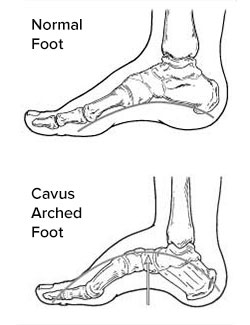What Causes a High-Arched (Cavus) Foot?
A high-arched foot (also cavus foot) is often caused by a neurologic disorder or other medical condition, such as cerebral palsy, Charcot-Marie-Tooth disease, spina bifida, muscular dystrophy, or stroke. Otherwise, it may be the result of an inherited structural abnormality.
Signs and Symptoms of Cavus Foot
The arch of the foot of someone with cavus foot will look high even when standing. You might also notice the following
- Hammertoes (bent) or claw toes (toes clenched like a fist)
- Calluses on the ball, side, or heel of foot
- Instability caused by the heel tilting inward, which can lead to ankle sprains.
Some people may also experience foot drop, which is a weakness of the muscles in the foot and ankle, resulting in dragging the foot when you take a step.
Diagnosis
The podiatrist will usually start by reviewing your family history for the diseases and disorders listed earlier. They will also examine your foot, looking for a high arch, calluses, hammertoes and/or clawtoes. They will check the muscle strength, walking pattern, and coordination. If a neurologic condition is apparent, the doctor may examine the entire limb. They may also order x-rays for further evaluation, and may also refer you to a neurologist if they feel it necessary.

